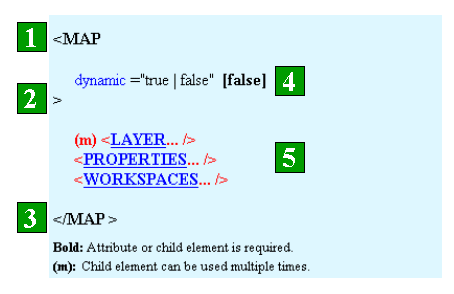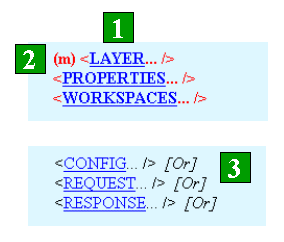The ArcXML element structure includes the element name, attributes, and child elements.
Element Name
- The opening element starts with a less than symbol (<) and is followed by its name. Elements are always written in uppercase letters.
- The opening element ends with a greater than symbol (>).
- The closing element is similar to the opening element. It begins with the less than symbol and a forward slash (/) and is followed by its name. The element ends with a greater than symbol.
- If the element includes any attributes, they are included after the opening element.
- All child elements are inserted before the closing element.
Attributes
- Attributes are always written in lowercase letters. If the attribute is required, it is bold. A definition of each attribute is found in the attribute table for the element.
- If an attribute has a defined list of valid values, all possible values are listed. Only one value can be used at a time. Attribute values are always placed inside of double quotes ("), and the text is not case sensitive unless noted.
- If the attribute has a default value, it is listed in brackets after the attribute list or type.
- If an attribute does not have a list of known values, the value type is listed such as double, integer, and string.
Child Elements
- Child elements are always written in uppercase letters. If the child element is required, it is bold. Each child element is linked to the corresponding page describing that element.
- Some child elements can be used multiple times. If this is the case, the letter "m" in parentheses (m) is in front of the child element.
- In some cases, special instructions are given in brackets after the element. The most common scenario is when a group of child elements is listed but only one child element can be used. In this example, [Or] means to select one child element from the group. More details are given in the Restrictions section to explain special instructions.



